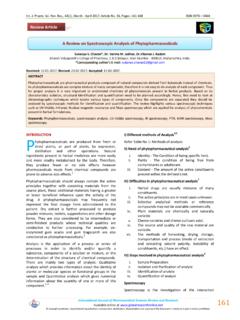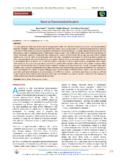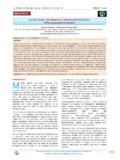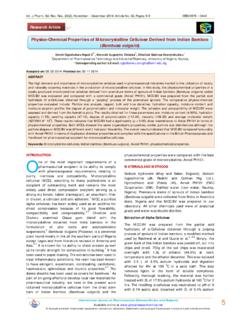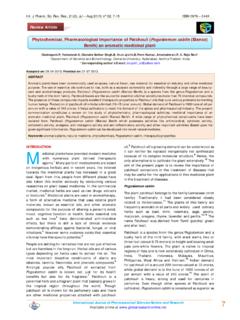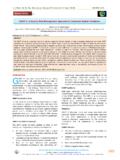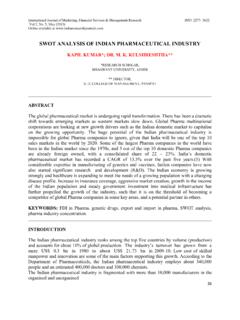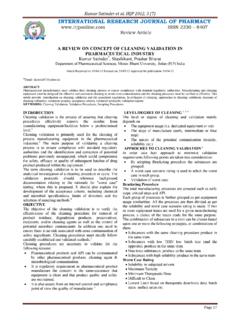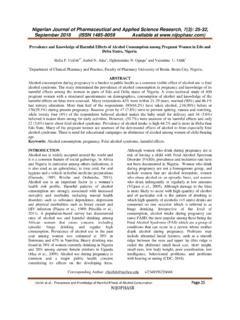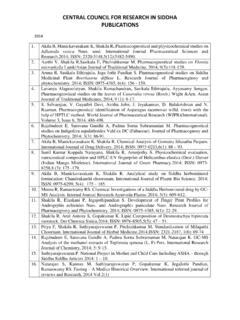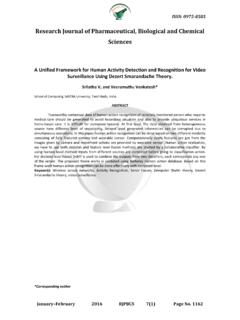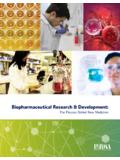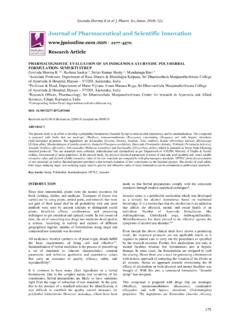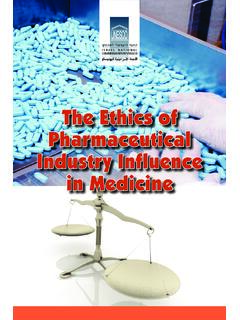Transcription of Research Article - International Journal of Pharmaceutical ...
1 Int. J. Pharm. Sci. Rev. Res., 44(1), May - June 2017; Article No. 08, Pages: 30-32 ISSN 0976 044X International Journal of Pharmaceutical Sciences Review and Research International Journal of Pharmaceutical Sciences Review and Research Available online at Copyright protected. Unauthorised republication, reproduction, distribution, dissemination and copying of this document in whole or in part is strictly prohibited. Available online at 30 Monica Antony, *, Vishnu Priya. V Department of Biochemistry, Saveetha Dental College and Hospitals, Poonamallee High Road, Chennai, India. *Corresponding author s E-mail: Received: 15-02-2017; Revised: 19-03-2017; Accepted: 24-04-2017.
2 ABSTRACT Acorus calamus is a plant used in traditional medicine. The Acorus calamus most extensively investigated phytochemically and pharmacologically. Cancer is characterized by a rapid and uncontrolled formation of abnormal cells. Apoptosis or programmed cell death is a highly organised physiological process to eliminate damaged or abnormal cells. Extractives of different parts of Acorus calamus and calamus oil are widely used now in pharmaceuticals, traditional systems of medicines for a number of ailments Acorus calamus decreased cell viability in malignant cells in a concentration dependent manner. Keywords: Acorus calamus, traditional medicine, apoptotic activity.
3 INTRODUCTION n the normal situations, the cells grow and divide as the body needs them. This process is disturbed when a new cell from the body does not require and old cells don t die when they should. These extra cell lumps together form a growth or tumour1. Cancer is characterized by a rapid and uncontrolled formation of abnormal cells, which may mass together to form a growth or tumour, or proliferate throughout the body, initiating abnormal growth at other sites. If the process is not arrested, it may progress until it causes the death of the organism2. APOPTOSIS or programmed cell death is a highly organised physiological process to eliminate damaged or abnormal cells.
4 It also plays a major role in embryogenesis where apparently normal cells undergo apoptosis. It is involved in maintaining homeostasis in multicellular organisms 7. Since long times plants have been provide essential nutritional values, medicinal properties and physiological effect to life and are a good source of food. Traditional medicine refers to the application, approach, knowledge and belief in incorporating plant and animal based properties in remedies for the purpose of treating or preventing disease as well as to maintain the well-being of an individual. Herbal remedies have been used to cure a variety of disorders like diabetes, sexual malfunction, and urinary tract infections in females, cardiovascular diseases, and weight control and used to cure many other ailments.
5 Plants have a long history of use in the treatment of cancer. Plants have played an important role as a source of effective anti-cancer agents and it is reported that over 60% of currently used anti-cancer agents are derived from natural sources, including plants, marine organisms and micro-organisms1. Acorus calamus (vasambu) Ayurvedic medicine is documented for treatment of insomnia, neurosis, and remittent fevers. Extractives of different parts of Acorus calamus and calamus oil are widely used now in pharmaceuticals, traditional systems of medicines for a number of ailments Acorus calamus decreased cell viability in malignant cells in a concentration dependent manner.
6 -asarone an important chemical constituent of A. calamus has also been reported to possess antibacterial activity. The synergistic anthelmintic activity of A. calamus and Vitex negundo was studied by Merekar et the induction of apoptosis leads to an activation of caspases. These enzymes are cysteine proteases that are produced by the cell as inactive pro- enzymes. After activation the pro caspase is hydrolysed to its active form, caspase. Caspases belong to a family of proteases which are responsible for the cell death induction. The activation of the caspase induces the cell fragmentation and thus the development of apoptoticbodies10.
7 Many of the plants have been studied scientifically and proved to be beneficial anti-cancer agents. In medicine, particularly in the field of cancer, the use of herbs is increasingly enhanced especially with the excessive use of synthetic drugs and awareness of their toxicity, which contributed in oncology, leading to a favourable reconsideration of the medicinal practices made from natural herbal. Despite the divergent bioactivities of the plant medicines against various diseases, active components of most plant extracts have not been elucidated thoroughly, due their complex mixtures.
8 The ability of agents to attach to carrier molecules directed to specific tumours, shows highly cytotoxic natural products to the tumours1. MATERIALS AND METHODS Preparation of Acorus calamus extract Powdered Acorus calamus was added to the solvent dichloromethane and allowed to settle for some time. Apoptotic Activity of Acorus calamus on Oral Cancer Cell Lines I Research Article Int. J. Pharm. Sci. Rev. Res., 44(1), May - June 2017; Article No. 08, Pages: 30-32 ISSN 0976 044X International Journal of Pharmaceutical Sciences Review and Research International Journal of Pharmaceutical Sciences Review and Research Available online at Copyright protected.
9 Unauthorised republication, reproduction, distribution, dissemination and copying of this document in whole or in part is strictly prohibited. Available online at 31 This was done to increase the efficiency of the extraction process. Maintenance of KB cell lines Cell culture flasks were selected by the method of confluency. They were observed under inverted microscope. In order to maintain cell line, the technique of subculturing was performed. This is to facilitate cell growth by extraction of cells from the existing medium and placing them into a fresh new medium. For cell maintenance, enzymatic methods using TPVG were prevalently used.
10 Growth medium is then extracted completely from the flasks and the cells were further subjected to incubation at 37 C after the addition of the enzyme. This, initially, detach the cells from the surface. Treatment of KB cells with Acorus calamus extract Aliquot of the extract (125 micro grams and 75 micro grams) was added and incubated with KB cell lines. Isolation of DNA 1*10 to the power of 6 cells were incubated with 100 l of cell lysis buffer at room temperature for one hour. This was centrifuged for 15 min at 3000rpm at 4 C to sediment the cell debris. To the supernatant equal volume of phenol: chloroform: isoamylalcohol mixture was added to the supernatant and mixed well.


